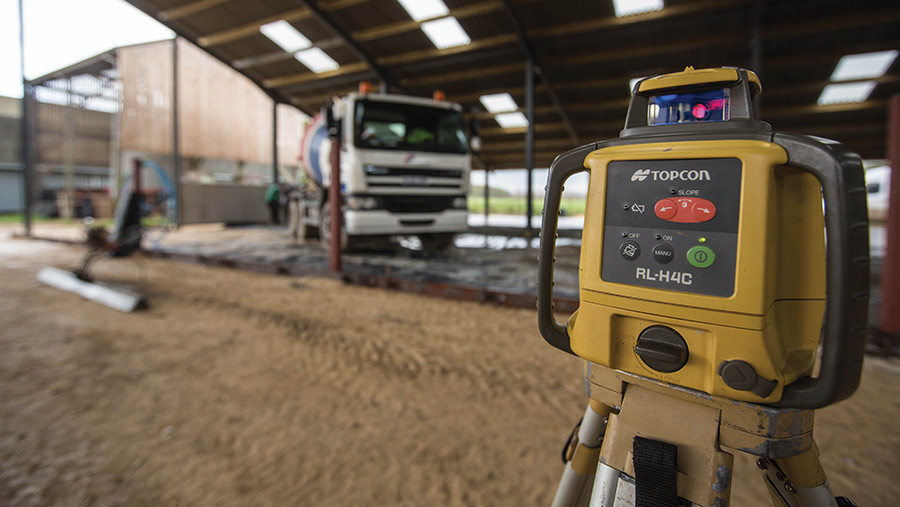Pitfalls to avoid when carrying out a farm building project
 © Tim Scrivener
© Tim Scrivener Farmers looking to erect a new grain store or livestock building could make big savings if they work to a detailed tender document and put in place a written contract to administer the works.
The cost of putting up a new shed can run into hundreds of thousands of pounds, yet too often farmers agree a building contract with little more than a phone conversation and a one-page quote.
“Most farmers don’t use contracts and a lot of the time they procure buildings in a way that leaves them vulnerable to the costs escalating,” warns Cameron McKenna, a building surveyor with Suffolk-based adviser Salter & McKenna.
See also: How to save time stress and cash on farm office routines
“A farm building is a very expensive investment, but a lot of farmers will get a quote for one where the contractor leaves certain things too open-ended.
“For example, the quote might say £100,000 for the grain store and then drainage at £27/m, but without the details of how many metres. So, suddenly you can have a bill for 100m or 200m of drainage at £27/m which can start to add a lot of cost.”
The absence of a detailed tender document can prove expensive if a farmer makes a request partway through a build to vary the contract – for example, wanting roller shutter doors rather than a cheaper alternative which may be included in a quote.
Farmers often want to project manage buildings themselves, but Cameron says in his experience using a construction professional can help save thousands of pounds, even accounting for their fee.
“If you are putting a building up for £150,000 you might be looking at a fee of £5,000-£6,000 for someone to project manage the whole lot. Although that sounds like a lot of money, you will save that.”
Top tips
- Put together a detailed brief before asking contractors to tender
- Try to avoid design changes as these can be expensive
- A building contract will protect both parties
- For larger projects, input from a construction professional could help to save money and reduce stress
Getting the tender right
His advice to anyone asking for a quote for a building is “detail, detail, detail”.
The more detailed design and specification you can give, the tighter the price that comes back and it can minimise the risk of problems during the build.
“For example, I’ve been involved with a lot of new-build farmhouses and always ask the clients to note the location of all the sockets they will want on the plan,” he says.
“If you put it out to quote without being specific, then suddenly the £10,000 that has been allocated to cover the cost of wiring becomes a £14,000-£15,000 job.”
He also advises people to shop around when it comes to finding a building contractor.
“If a company is known for doing all the farm buildings in an area, they sometimes won’t have the incentive to be as competitive as they could be, so get quotes from elsewhere.”
However, decisions should not just be based on price, it is also about quality, so seek out recommendations from people you trust.
“Ask if they had a good experience but, crucially, what was the company like when things went wrong,” says Cameron.
“What did they do? Were they honourable? Did they put their hands up and come back and sort things out, or did they shrug their shoulders?”
Why have a written contract?
A building contract protects both parties of the agreement – the client (known as the employer) and the contractor – by providing written terms and conditions.
Standard contracts are available from several sources, one of the most well-known being the Joint Contracts Tribunal (JCT) suite of contracts, which can be used in England and Wales.
Versions adapted to Scottish law are produced by the Scottish Building Contract Committee.
The type of contract required will depend on the value and duration of the work.
Most contracts need a contract administrator who is paid by the client to supervise the contract, but must act impartially between the parties.

© Tim Scrivener
Variations
Some of the most important clauses in the contract are mechanisms to deal with variations, or changes, as the project progresses.
For example, in the case of a farmhouse, if the contract states there should be a flagstone floor but the client decides they would prefer a vinyl floor, the contract administrator would adjust the contract accordingly and then agree the cost implications with the contractor.
A JCT contract is advisable for projects such as farmhouses and for more complex farm building projects, says Cameron.
There is no templated contract specifically for the construction of standard farm buildings, but there are principles that farmers could take from the other templates and build into an agreement with their building supplier.
These include:
Health and safety
Health and safety is a very important part of the build process and is often overlooked by farmers, who may assume that their contractor takes responsibility for ensuring appropriate safety measures are put in place.
Those having work done need to comply with the Construction (Design and Management) Regulations 2015.
These apply to anyone having construction or maintenance work carried out and outline their responsibilities as a client and ensure construction work and repairs are undertaken safely, without damaging workers’ and other people’s health.
Failure to comply with the regulations will leave the farmer exposed to heavy fines and even a prison sentence in the worst cases.
“The farmer has overall responsibility for health and safety and must make sure measures are put in place,” says Cameron.
Any project over 500 man hours or 30 days must be notified to the Health and Safety Executive (HSE).
Insurance
The JCT contracts are clear about who should take out insurance.
Either the contractor insures under joint names, or the client (employer) does, or if working on an existing building the client insures the building, while the contractor must have public liability and employers’ liability insurance in place.
Where a farmer chooses to manage a project themselves, they should check with the building contractor at the tender stage who takes responsibility for insurance and ask for confirmation of the covers that are the contractor’s responsibility.
This includes having sight of that cover.
Liquidated damages
Liquidated damages is the term used for clauses in standard building contracts setting out what will happen if the project is not completed within the contract period.
The payment is to reflect the client’s losses should the project not be completed on time.
For instance, if a grain store needs to be ready for August and the contractor has failed to meet the deadline, the liquidated damages would be a certain amount per week until it is ready.
The amount payable would normally be calculated and stated within the contract terms.
Liquidated damages are based on the amount of money required to put the client in the same position they would have been if the building had been completed on time.

© iStockphoto.com/Artist GND Photography
Detailed schedule of works
Having a detailed schedule of works priced and agreed at the outset can help to avoid disputes about staged payments.
There is a risk that some contractors will try to frontload payments, so if anything goes wrong during the build they have already had their money.
So, at the point of tender, ask contractors to split their quote down to a detailed list of its constituent parts, with a cost set against each of them.
For example, the quote could be split as follows:
- Site clearance
- Foundations
- Structure
- Roof
- Drainage
- Internal finishes
- Services
- Landscaping
“When you are looking at payment stages, you can pay in line with what they have done,” says Cameron.
If a JCT contract is being used and there is a contract administrator in place, the process is that the contractor submits a valuation for payment and then the administrator either agrees with the valuation or disputes it.
If the valuation is disputed, a notice to pay less is issued and this notice will give all the reasons for the lower payment.
The contractor will only be paid the sum that the certificate states.
If the contractor disputes the certified sum, this can be rectified at the next payment if it is agreed.
HSE guide
For those having work done, there is an HSE guide “Need building work done?” (PDF) to their responsibilities under the Construction (Design and Management) Regulations 2015.
